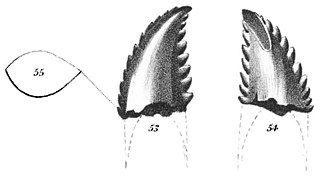
Troodon is a former wastebasket taxon and a potentially dubious genus of relatively small, bird-like dinosaurs known definitively from the Campanian age of the Late Cretaceous period. It includes at least one species, Troodon formosus, known from Montana. Discovered in October 1855, T. formosus was among the first dinosaurs found in North America, although it was thought to be a lizard until 1877. Several well-known troodontid specimens from the Dinosaur Park Formation in Alberta were once believed to be members of this genus. However, recent analyses in 2017 have found the genus to be undiagnostic and referred some of these specimens to the genus Stenonychosaurus and others to the genus Latenivenatrix. Thus, it is still controversial if Troodon is valid.
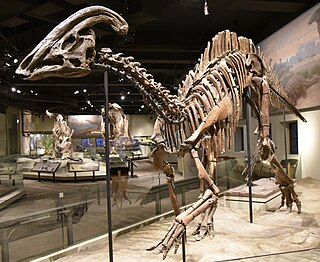
Parasaurolophus is a genus of herbivorous hadrosaurid ornithopod dinosaur that lived in what is now North America and possibly Asia during the Late Cretaceous Period, about 76.5–73 million years ago. It was a herbivore that walked both as a biped and as a quadruped. Three species are universally recognized: P. walkeri, P. tubicen, and the short-crested P. cyrtocristatus. Additionally, a fourth species, P. jiayinensis, has been proposed, although it is more commonly placed in the separate genus Charonosaurus. Remains are known from Alberta (Canada), New Mexico and Utah, and possibly Heilongjiang (China). The genus was first described in 1922 by William Parks from a skull and partial skeleton found in Alberta.
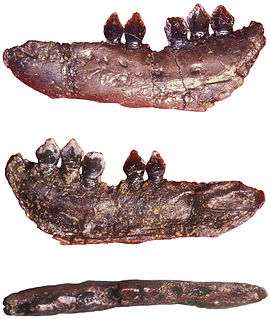
Echinodon is a genus of heterodontosaurid dinosaur that lived during the earliest Cretaceous of southern England and possibly western France in the Berriasian epoch. The first specimens were jaw bones named Echinodon becklesii by Sir Richard Owen in 1861, and since their original description only additional teeth have been discovered. The specific name honours collector Samuel Beckles who discovered the material of Echinodon and many other taxa from across England, while the genus name translates as "prickly tooth" in reference to the dental anatomy of the taxon.

Macrogryphosaurus is a genus of elasmarian dinosaur from the Coniacian age Upper Cretaceous Sierra Barrosa Formation of Argentina in Patagonia. It was described by Jorge Calvo and colleagues in 2007, with M. gondwanicus as the type and only species.
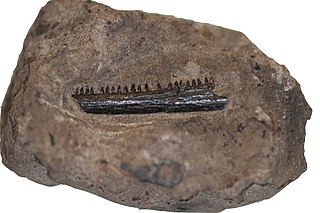
Cteniogenys is a genus of choristodere, a morphologically diverse group of aquatic reptiles. It is part of the monotypic family Cteniogenidae. The type and only named species, C. antiquus, was named in 1928 by Charles W. Gilmore. The holotype, VP.001088, was collected in the Morrison Formation, Wyoming in 1881 by William H. Reed. More specimens have been discovered since then, including specimens from the Late Jurassic of Portugal and Middle Jurassic of Britain, which have not been assigned to species.
Paramacellodus is an extinct genus of scincomorph lizards from the Early Cretaceous of England and France, and the Late Jurassic of Portugal and the western United States. The type species, Paramacellodus oweni, was named in 1967 from the earliest Cretaceous (Berriasian) Purbeck Group in Dorset, England. Additional material referable to a species of Paramacellodus, possibly P. oweni, has been described from the Morrison Formation, specifically in Como Bluff, Wyoming, and Dinosaur National Monument, Utah. An indeterminate species is known from the Berriasian aged Angeac-Charente bonebed in France. Paramacellodus belongs to an extinct family of scincomorphs called Paramacellodidae, which spanned most of Laurasia during the Late Jurassic and Early Cretaceous and represented one of the earliest evolutionary radiations of lizards.

The La Pedrera de Rúbies Formation is an Early Cretaceous (late Berriasian to early Barremian geologic formation in Catalonia, Spain. The formation crops out in the area of the Montsec in the Organyà Basin. At the La Pedrera de Meià locality, the formation consists of rhythmically laminated, lithographic limestones that formed in the distal areas of a large, shallow coastal lake. It is noted for the exceptional preservation of articulated small vertebrates and insects, similar to that of the Solnhofen Limestone.
Pedrerasaurus is an extinct genus of scincogekkonomorph lizard from the Early Cretaceous (Barremian) La Pedrera de Rúbies Formation of Spain. The type species is P. latifrontalis. It is similar in appearance to Meyasaurus, a widespread Early Cretaceous lizard that is also known from the Iberian Peninsula. Both genera have bicuspid (two-cusped) teeth, but unlike Meyasaurus, Pedrerasaurus has frontal bones that are not fused or constricted.
Liushusaurus is an extinct genus of lizard described by Susan E. Evans and Yuan Wang in 2010. The genus has a single species, Liushusaurus acanthocaudata, and is known from eight fossils, several of which preserve soft tissue detail. The specimens were found in the Lower Cretaceous aged Yixian Formation of Northeast China. Liushusaurus is one of eight lizards that are known and have been named from the Yixian Formation, part of the diverse Jehol Biota ecosystem.
Note: In 2012, the International Code of Zoological Nomenclature was amended, with new regulations allowing the publication of new names and nomenclatural acts in zoology after 2011, in works "produced in an edition containing simultaneously obtainable copies by a method that assures (...) widely accessible electronic copies with fixed content and layout", provided that the work is registered in ZooBank before it is published, the work itself states the date of publication with evidence that registration has occurred, and the ZooBank registration states both the name of an electronic archive intended to preserve the work and the ISSN or ISBN associated with the work. New scientific names appearing in electronic works are not required to be registered in ZooBank, only the works themselves are. Works containing descriptions of some of the taxa listed below were not printed on paper in 2012; however, the taxa that were described in works which were registered in ZooBank in 2012 are listed as valid.
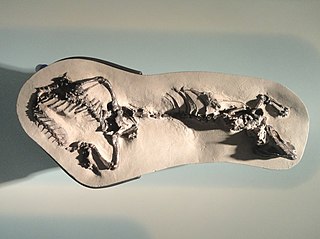
Polyglyphanodontia, also known as the Borioteiioidea, is an extinct clade of lizards from the Cretaceous that includes around a dozen genera. Polyglyphanodontians were the dominant group of lizards in North America and Asia during the Late Cretaceous. Most polyglyphanodontians are Late Cretaceous in age, though the oldest one, Kuwajimalla kagaensis, is known from the Early Cretaceous Kuwajima Formation (Japan). Early Cretaceous South American taxon Tijubina, and possibly also Olindalacerta, might also fall within Polyglyphanodontia or be closely allied to the group, but if so, they would be two of only three Gondwanan examples of an otherwise Laurasian clade. They produced a remarkable range of forms. Chamopsiids, including Chamops, were characterized by large, blunt, crushing teeth, and were most likely omnivores. Macrocephalosaurus, from the Gobi Desert, was a specialized herbivore; it grew to roughly a meter long and had multicusped, leaf-shaped teeth like those of modern iguanas. Polyglyphanodon, from the Maastrichtian of Utah, was another herbivore, but its teeth formed a series of transverse blades, similar to those of Trilophosaurus. Peneteius had remarkable, multicusped teeth, similar to those of mammals. The polyglyphanodontids first appear in the latter part of the Early Cretaceous in North America, and became extinct during the Cretaceous-Paleogene extinction event. Polyglyphanodontians closely resembled the teiid lizards, and purported teiid lizards from the Late Cretaceous appear to be polyglyphanodontians. The only species known to have survived the Cretaceous was Chamops, which survived until the very early Ypresian.

The Lacertoidea is a group of squamate reptiles that includes the Lacertidae, Teiidae, Gymnophthalmidae, and Amphisbaenia. The finding from molecular phylogenetic studies that the burrowing Amphisbaenia were nested in a clade with the lizard forms led Vidal & Hedges (2005) to propose a new name for the group based on shared morphogical characters, Laterata, "referring to the presence of tile-like scales that form the rings in Amphisbaenia, and are also present ventrally in Lacertiformata and Teiformata".
Asprosaurus is an extinct genus of anguimorph lizard from the Late Cretaceous of South Korea. Named in 2015 from the Seonso Conglomerate Formation, the type species Asprosaurus bibongriensis is the first Mesozoic lizard to have been discovered on the Korean peninsula. Because Asprosaurus is known only from fragmentary material, its relationships with other lizards are uncertain. However, features of the lower jaw suggest that it may be a member of a clade called Monstersauria, which includes the living Gila monster.
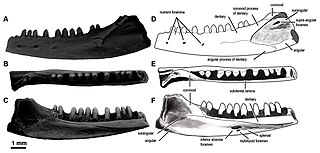
Paramacellodidae is an extinct family of lizards that first appeared in the Middle Jurassic around 170 million years ago (Ma) and became extinct at the end of the Cretaceous around 66 Ma. It was one of the earliest groups of lizards to have undergone an evolutionary radiation, with members found across the supercontinent Laurasia. The phylogenetic relationships and constituent species of Paramacellodidae are uncertain. Many studies regard them to be scincomorphs, a large group that includes skinks and their closest extinct relatives, and possibly also to Cordyoidea, a group that includes spinytail lizards and relatives. Like modern skinks, paramacelloidids had rectangular bony plates called osteoderms covering most of their bodies, including their backs, undersides, and tails. They also had short and robust limbs. Paramacellodids are distinguished from other lizards by the combination two traits in their dentition, the teeth are labiolingually expanded at their bases, and the tooth apices are lingually concave.
Bharatagama is an extinct genus of lepidosaur from the Early Jurassic of India. It is has been suggested to be one of the oldest known lizards and the oldest known iguanian. The type and only species is Bharatagama rebbanensis, named in 2002. Over one hundred fossils of Bharatagama have been found in the Kota Formation, which outcrops in the Pranhita–Godavari Basin and dates back to about 190 million years ago (Ma). Despite its abundance, Bharatagama is known only from isolated jaw bones mixed together in microvertebrate assemblages with equally fragmentary remains of fish, sphenodontians, dinosaurs, crocodylomorphs, and mammals. These fossils represent all stages of development, from hatchlings to adults. The total length of the skull in adult specimens is estimated to have been about 15 millimetres (0.59 in). Later analysis suggested that the taxon might be a member of Rhynchocephalia.

Eichstaettisaurus is a genus of lizards from the Late Jurassic and Early Cretaceous of Germany, Spain, and Italy. With a flattened head, forward-oriented and partially symmetrical feet, and tall claws, Eichstaettisaurus bore many adaptations to a climbing lifestyle approaching those of geckoes. The type species, E. schroederi, is among the oldest and most complete members of the Squamata, being known by one specimen originating from the Tithonian-aged Solnhofen Limestone of Germany. A second species, E. gouldi, was described from another skeleton found in the Matese Mountains of Italy. Despite being very similar to E. schroederi, it lived much later, during the Albian stage. Fossils of both species show exceptional preservation due to deposition in low-oxygen marine environments.

Dolichosauridae is a family of Cretaceous aquatic ophidiomorphan lizards closely related to the snakes and mosasaurs.
Purbicella is a genus of extinct squamate from the Early Cretaceous of southern England. The type and only species is Purbicella ragei, which was described by Susan E. Evans and colleagues in 2012 for a mostly complete and articulated skull from the Berriasian Lulworth Formation of Dorset. The generic name described the region of Purbeck where the fossil was found, while the species name honours paleoherpetologist Jean-Claude Rage. Purbicella has the most complete skull of any British fossil lizard, British Geological Survey (BGS) specimen GSb581, which was originally collected prior to 1911, but then remained in BGS storage until it was rediscovered and described by Evans and colleagues. The skull is unique among coexisting taxa for having fused frontal bones, and Purbicella is likely closer to modern lacertoids than any of the other British forms.
Durotrigia is a genus of extinct lizard from the Early Cretaceous of southern England. The type and only species is Durotrigia triconidens, named in 1967 by R. Hoffstetter for jaw material in a review of the lizard fauna of the Berriasian Lulworth Formation. The genus was found in the Mammal Bed near the base of the formation alongside the other lizards Paramacellodus, Becklesius, Pseudosaurillus, Dorsetisaurus, Saurillus and Parviraptor. Durotrigia is likely a genus within the family Globauridae.
Pseudosaurillus is a genus of extinct lizard from the Early Cretaceous of southern England. The type and only species is Pseudosaurillus becklesi, named in 1967 by R. Hoffstetter limited jaw and tooth material from the Berriasian Lulworth Formation. A large amount of material that was additionally referred to Saurillus by Hoffstetter was reassigned to Pseudosaurillus in 1983 by Estes, but this has since been reclassified within its own genus Parasaurillus by Susan E. Evans and Belinda Searle in 2002. The taxon was found in the Mammal Bed near the base of the formation alongside the other lizards Becklesius, Dorsetisaurus, Durotrigia, Paramacellodus, Parasaurillus, Parviraptor and Saurillus. Like Becklesius, Pseudosaurillus may be a member of the family Paramacellodidae.










